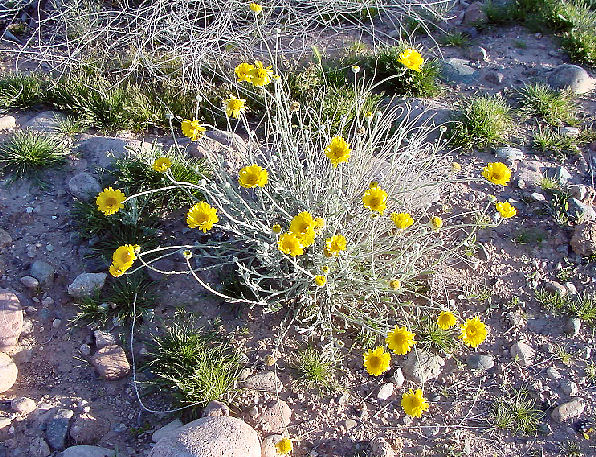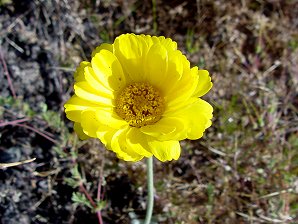Arizona Wild Flowers
Pictures, Photos, Images
Descriptions, Information, Reviews.
Desert Marigold, Baileya multiradiata.
We Are Proud Of Our SafeSurf Rating!
Click On Any Of The Following Links By Amazon.Com
For Books, & Videos About Wildflowers Of Arizona & The Southwest USA. No Obligation!
 |
| Desert Marigold, Baileya multiradiata. |
|---|
 |  |
| Desert Marigold, Baileya multiradiata. | Other Common Names: Paper Daisy, Wild Marigold. |
|---|
 /
/

Desert Marigold.
We wish to thank Wikipedia, the free encyclopedia for some of the information on this page. We share images and information with Wikipedia. Desert Marigold, either fresh or dried, is poisonous to sheep and goats, but not to horses or cattle.
Quick Notes:
Height: Up To About 1/2 to 1 feet tall.
Flowers: Yellow flower heads are 1 to 1 3/4 inches across, with 20 to 50 bright yellow ray flowers ("petals"). These do not drop off, but are persistent and become faded, papery, and turned downward in age. The flower heads are mostly borne singly at the tips of the stems and branches on long naked stalks, 4 to 8 inches long.
Each head produces at least 100 achenes, which are rodshaped, about 1/8 inch long, light brown, with many longitudinal nerves on the surface.
Flowering Time: Mid March - November.
Leaves: Soft, woolly leaves are alternate, clustered largely at the base of the plant and divided into irregular close set lobes, or some are divided again. The upper leaves are few lobed, or may be narrow and smooth edged.
Found: Native to the Mojave and Sonoran Deserts of California, the Southwestern United States, and northwestern Mexico. Found throughout lower elevations in Arizona.
Hardiness:
Soil pH requirements:
Sun Exposure:
Elevation: 0 to 5,000 feet.
Habitat: Dry, well-drained sandy, gravelly, and rocky soils on upper bajadas and moderate slopes in the lower mountains. A most attractive and abundant plant along roadsides, plains, and mesas. An ideal xeriscape landscape plant in Arizona.
Miscellaneous: Flowering Photos Taken April 29, 2003. Near Lake Pleasant, Arizona.
|



We Are Proud Of Our SafeSurf Rating!
Click On Any Of The Following Links By Amazon.Com
For Books, & Videos About Xerioscape Plants Of Arizona & The Southwest USA. No Obligation!
Back To Arizona Wild Flowers Home Page.
Back To Arizona Wild Flowers, Yellow Flowers Page One.
Back To Arizona Xeriscape Landscaping Main Page.
Back To Xeriscape Perennials Page One.
Back To DeLange Home Page
© 1966 - Present, Audrey, Eve, & George DeLange
| © 1966 - Present, Audrey, Eve, & George DeLange |


